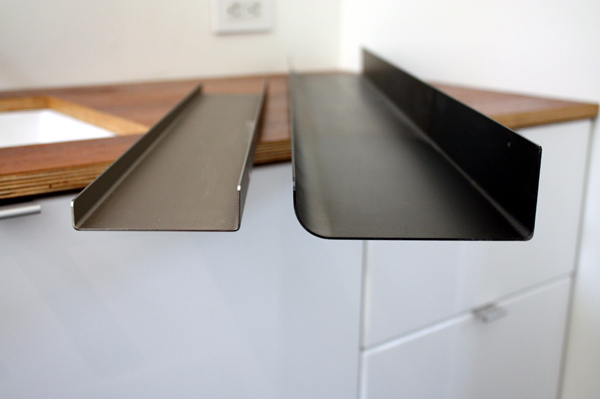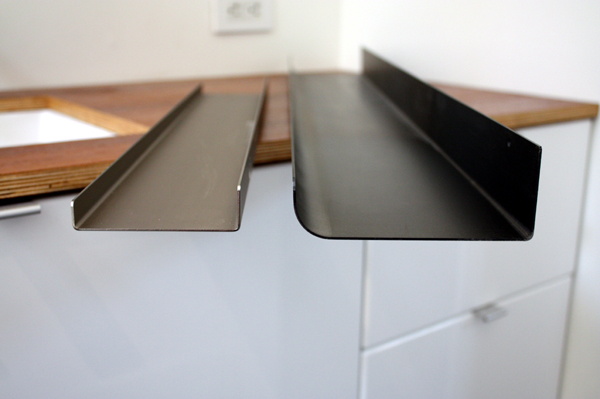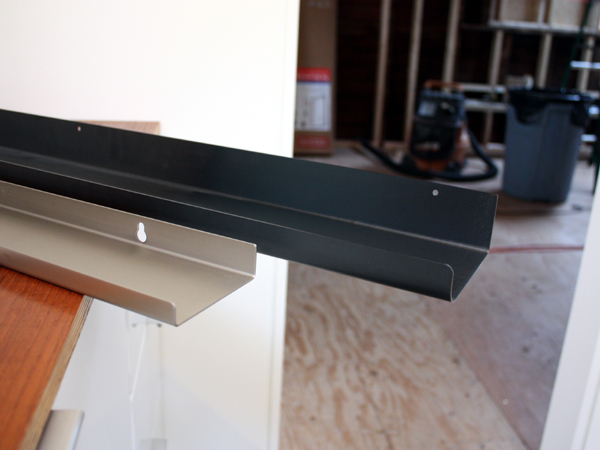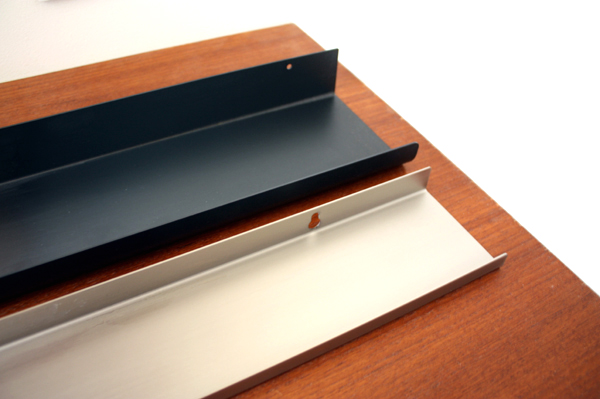Although it may seem a little premature, we need to make a decor decision. Back in January, we posted some images of our sketchup model that showed a slim black line running from the kitchen backsplash, through the dining room and into the living room. This black line is intended to be a steel ledge that helps visually tie the spaces together and serves as a multi-purpose storage/display system. (For instance, in the kitchen it will hold spices and other commonly used small items and in the dining and living room it will be a display space for pictures of Ferraris artwork, bud vases and whatever else captures our attention. )
And now that we have everything opened up, we need to install a row of blocking to attach the ledges to (this isn’t completely necessary but will give us more flexibility as we won’t have to depend on stud locations or use drywall anchors). But what ledges to use? We’ve seen a couple of versions floating around the interwebs, and came across two we liked from West Elm and Room&Board.
We tracked down one of each, knowing that it would be important to test out in person. On the left is the West Elm version. It’s 3.5″ deep, 1″ tall and comes in lengths of 2′, 3′, and 4′. The price is about $12-$17/linear foot and it comes in just the brushed finish. The Room&Board option on the right is 5″ deep and 2″ tall and comes in lengths of 3′, 4′, 5′, and 6′. It costs anywhere from $17-$23/linear foot and comes in either natural or stainless steel.
The R&B option is appealing because it comes in longer lengths which means we wouldn’t have to join shorter segments together. But it is also bigger and more heavy-duty than we really need.
The West Elm ledge has crisper corners and the proportions fit our space and application better. The downside, we’d have to butt a couple runs together to work with our design. We were also worried about potential flimsiness, but both products seem really solid and well-constructed.
Ultimately, we’ve decided on the smaller, West Elm ledge. We’re not crazy about the slotted fastener holes, but the idea is to actually put stuff on the ledge so maybe it’s not a big deal. We could also cover the holes with a small piece of fir trim. Hmm, we’ll have to revisit this later…when we actually have finished walls.




Have you considered having the shelf fabricated by a local sheet metal shop? You could get much longer lengths and have it finished in whatever finish you wanted. My guess is that it would be cheaper than purchasing many short lengths from a retail outlet.
perhaps a local metal shop could fabricate something in the same LF price point? That way you could get longer runs and avoid the holes. we have a hot rolled steel angle bracket as a display edge at our office and it was scrap at a local shop.
just a thought. i love the idea of the ledge running through both rooms!
ditto on the comments above, check a local metal manufacturer. have you considered installing it prior to the drywall so that you actually would not see the fastners/holes? but then it would be much more permenant 🙂
Thanks for all of the suggestions everyone! We did think about going the custom route, but were a little resistant for a couple of reasons:
1. We had custom profile gutters priced out for our roof a few years ago (we couldn’t bring ourselves to use the fussy shapes sold at the big box stores), but it was crazy expensive for something we thought was pretty simple and straight forward.
2. We really liked the West Elm product and felt ok that there would be only one place where we’d have to butt two shorter pieces together. (Basically we have a 5′ section (so a 2′ + 3′) at the kitchen backsplash, a 2′ section between the fridge and the window, and a 4′ section on the opposite side of the window.)
However, maybe we should give it another shot! Anyone in the Seattle area have some a favorite metal shop?
I love the clean look of the west elm ledges, but ditto the recs to at least look into local metal fabricators. But really, if it’s just one spot where you’re piecing 2 shorter lengths together I don’t think it’s a big deal. If you do go custom though you could also specify weight/sturdiness and do smaller fastener holes if teh slotted ones bother you.
Just wanted to also say I love your blog! I’ve been lurking for a few months. I’ve just started my own kitchen remodel and I visit here often to look for new ideas.
Thanks Laura! We’re definitely going to look into it. Even though we need to do the blocking now, we still have a looong time before we’ll actually install the ledges. As is often the case when remodeling, I think we got into one of those, “oh crap…we have to figure this out NOW” situations and turned to our online resources instead of shopping around and seeing what was available locally.
hey guys… I’m in good with a few metal shops over on this side. that is a really simple profile with only two breaks. it should be no problem for any of the outfits I am familiar with. price point would be very reasonable as well, as this is not a high labor job….
oh— and I also have access to some steel suppliers, so… if you were REALLY wanting to cut price down. buy it yourself, deliver it to a shop for bending, then you cut down on the steel shops markup for stock… and ditto on the pre drywall hanging of the ledge??? ok– I get excited about steel, I’ll go now.
I love the ledges. The butted joint will probably be lost amongst the rest of the work.
Congratulations on being the first week’s winner of the Before & After contest. Your transformation of the front of your home is fantastic! I blogged about it….and I am looking forward to watching the rest of your remodel. We live in a house built in 1920 and have done a lot of work to it, so I completely understand! Lisa~
Thanks Lisa!
So I was looking up steel ledges because I’m considering having one in my own digs, and I came across these guys on ebay and immediately (of course) remembered this dilemma. Their ledge is 2″ deep, so I don’t know if that would work for you all, but they make them in up to 6 foot segments with the option to custom order. They’re also really cheap! Thought you might want to check it out:
http://cgi.ebay.com/ws/eBayISAPI.dll?ViewItem&item=330449567816&rvr_id=&crlp=1_263602_263622&UA=M*S%3F&GUID=013bd7f01270a02652f01f60ff95cfdc&itemid=330449567816&ff4=263602_263622#ht_2985wt_1113
The house is looking amazing, by the way!
Thanks Daniel, nice find! They’re very similar to the West Elm ones, though as you mentioned, a bit shallower. I think we’re going to try and make the West Elm ones work since we only have one place where we have to butt two runs together and uh…because we already bought them. =)